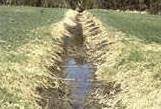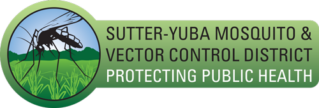The fact that fish have become valuable to mosquito control was recognized in the late 19th century. In 1905 mosquitofish were transported from their native environment to New Jersey and Hawaii and also to California in 1922. By 1923, 25 hatcheries had been established in our state and mosquitofish were made available to counties for anti-malarial mosquito control work.
Mosquitofish will eat whatever food is available to them. They consume both plant and animal life. They are also surface feeders and are attracted to motion, much like a cat is. Studies have shown that a single mosquitofish can eat up to 50 mosquito larvae in a 30 minute period and a maximum of 168 in an eight hour period.
Mosquitofish are live bearers. They can give birth to just a few fry on up to a couple of hundred baby fish. This process can reoccur 3-5 times during a season, typically in the warmer months. Some female mosquitofish born early in a reproductive season may themselves produce 1 or 2 broods of fish that same season. So a mosquitofish population in a particular environment can radically increase its population in a short period of time.
Mosquitofish are currently the best choice for mosquito larvae control in our area. There are other species of larvae-eating fish, however mosquitofish not only tolerate poor environments, but they can proliferate. Mosquitofish will survive in highly organic water. They do well in sewer ponds and other waters high in particulates and contaminants. They are able to survive in waters with low levels of dissolved oxygen where other fish species will suffocate. They have an extremely wide range of tolerance to temperature variation. Mosquitofish stocks in Utah have been documented to have survived water temperatures as low as 32.9°F. In Arizona the fish have been observed living in hot springs with temperatures in excess of 107°F. Also, mosquitofish are used in brackish waters.
 Our district makes use of mosquitofish in thousands of mosquito sources annually. Technicians evaluate a mosquito source based on how long they believe the particular water source will last and if the water source looks as if it will support fish life. Some typical sites where mosquitofish are used include: stock troughs, ditches, ornamental ponds, rice fields, sewage oxidation ponds, barrow pits, sumps, agricultural or irrigation seepage, and other areas where water will produce mosquito larvae for a long period of time.
Our district makes use of mosquitofish in thousands of mosquito sources annually. Technicians evaluate a mosquito source based on how long they believe the particular water source will last and if the water source looks as if it will support fish life. Some typical sites where mosquitofish are used include: stock troughs, ditches, ornamental ponds, rice fields, sewage oxidation ponds, barrow pits, sumps, agricultural or irrigation seepage, and other areas where water will produce mosquito larvae for a long period of time.
Mosquitofish are available to residents of the district from April 1st through October 1st each year, free of charge, for stocking backyard mosquito sources only. Mosquitofish may not be released by the public into lakes, creeks, streams, rivers or any source that leads to these waters. It is against California Department of Fish and Game regulations for private citizens to plant mosquitofish in waters of the State without a permit. (Title 14 CCR, Fish and Game Code, Section 1.63, Section 6400, and Section 238.5)
The fish can be picked up at 701 Bogue Road in Yuba City between the hours of 7 AM and 3 PM Monday thru Friday. A small ice chest with a tight fitting lid or a similar container is necessary for transportation. Or give us a call at (530) 674-5456. We may be able to arrange for a technician to deliver fish to your mosquito source when in your area.
As of July 14, 2011 the SYMVCD has adopted a MOSQUITOFISH STOCKING POLICY.
